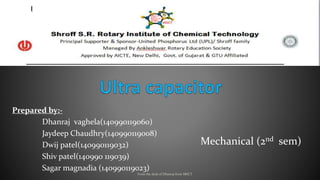
ultracapacitor
- 1. Prepared by:- Dhanraj vaghela(140990119060) Jaydeep Chaudhry(140990119008) Dwij patel(140990119032) Shiv patel(140990 119039) Sagar magnadia (140990119023) Mechanical (2nd sem) From the desk of Dhanraj from SRICT
- 2. 1. Introduction 2. Principle, construction and working of Ultra capacitor 3. Advantage, disadvantage and application From the desk of Dhanraj from SRICT
- 3. From the desk of Dhanraj from SRICT 1.Introduction In general, capacitor is a device to store the charge in an electric circuit. Basically, a capacitor is made up of two conductors separated by an insulator called dielectric. The dielectric can be made of paper, plastic, mica, ceramic, glass, a vacuum or nearly any other nonconductive material. Some capacitors are called Electrolytic in which the dielectric is aluminum foil conductor coated with oxide layer.
- 4. From the desk of Dhanraj from SRICT The electron storing capacity of capacitor is measured in unit Farads. One farad is approximately the charge with 6,280,000,000,000,000,000 electrons. Definition:Ultracapacitors can be defined as a energy storage device that stores energy electrostatically by polarizing an electrolytic solution. Unlike batteries no chemical reaction takes place when energy is being stored or discharged and so ultra capacitors can go through hundreds of thousands of charging cycles with no degradation. Ultra capacitors are also known as double-layer capacitors or super capacitors.
- 5. From the desk of Dhanraj from SRICT 2. Principle, construction and working • Principle Energy is stored in ultracapacitor by polarizing the electrolytic solution. The charges are separated via electrode –electrolyte interface. Current Collector Electrolyte Separator Porous electrode + _
- 6. • Construction Ultra capacitor consist of a porous electrode, electrolyte and a current collector (metal plates). There is a membrane, which separates, positive and negative plated is called separator. The following diagram shows the ultra capacitor module by arranging the individual cell C1 C 2 C3 C 4 C 5 Ultracapacitor stack + -- From the desk of Dhanraj from SRICT
- 7. • Working There are two carbon sheet separated by separator. The geometrical size of carbon sheet is taken in such a way that they have a very high surface area. The highly porous carbon can store more energy than any other electrolytic capacitor. When the voltage is applied to positive plate, it attracts negative ions from electrolyte. When the voltage is applied to negative plate, it attracts positive ions from electrolyte. From the desk of Dhanraj from SRICT
- 8. Therefore, there is a formation of a layer of ions on the both side of plate. This is called ‘Double layer’ formation. For this reason, the ultracapacitor can also be called Double layer capacitor. The ions are then stored near the surface of carbon. The distance between the plates is in the order of angstroms. According to the formula for the capacitance, Dielectric constant of medium X area of the plate Capacitance = --------------------------------------------------------------------- Distance between the plates From the desk of Dhanraj from SRICT
- 9. Ultracapacitor stores energy via electrostatic charges on opposite surfaces of the electric double layer. They utilize the high surface area of carbon as the energy storage medium, resulting in an energy density much higher than conventional capacitors. The purpose of having separator is to prevent the charges moving across the electrodes. The amount of energy stored is very large as compared to a standard capacitor because of the enormous surface area created by the (typically) porous carbon electrodes and the small charge separation (10 angstroms) created by the dielectric separator From the desk of Dhanraj from SRICT
- 10. • Advantage Long life: It works for large number of cycle without wear and aging. Rapid charging: it takes a second to charge completely Low cost: it is less expensive as compared to electrochemical battery. High power storage: It stores huge amount of energy in a small volume. Faster release: Release the energy much faster than battery. From the desk of Dhanraj from SRICT 3. Advantage, disadvantage and application
- 11. • Disadvantage They have Low energy density Individual cell shows low voltage Not all the energy can be utilized during discharge They have high self-discharge as compared to battery. Voltage balancing is required when more than three capacitors are connected in series. From the desk of Dhanraj from SRICT
- 12. • Applications They are used in electronic applications such as cellular electronics, power conditioning, uninterruptible power supplies (UPS), They used in industrial lasers, medical equipment. They are used in electric vehicle and for load leveling to extend the life of batteries. They are used in wireless communication system for uninterrupted service. There are used in VCRs, CD players, electronic toys, security systems, computers, scanners, smoke detectors, microwaves and coffee makers. From the desk of Dhanraj from SRICT
- 13. From the desk of Dhanraj from SRICT